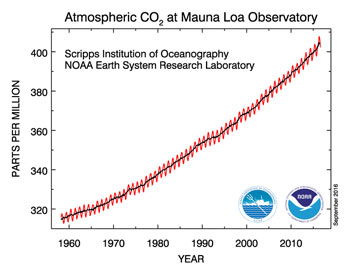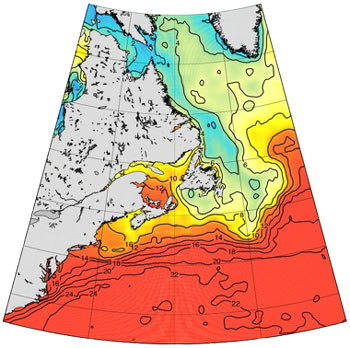Lobster, Ocean Acidity and Temperature Data Evolving

That carbon dioxide levels have been rising has been known for decades. Studies in the relatively pristine mountains of Hawaii have confirmed this conclusion. Mauna Loa Observatory (MLO) is a premier atmospheric research facility that has been continuously monitoring and collecting data related to atmospheric change since the 1950’s. The undisturbed air, remote location, and minimal influences of vegetation and human activity at MLO are ideal for monitoring constituents in the atmosphere that can cause climate change.
What scientists know with certainty about the impact of rising ocean acidity on American lobster and other sea animals is that the problem is far more complicated than previously thought.
That the carbonic acid formed when the ocean absorbs atmospheric carbon dioxide dissolves the shells of sea animals is a well known. However, on closer examination scientists are discovering wide variations within that known. Variations subject to water temperatures, local inshore and offshore conditions, currents, micro-habitat anomalies, high and low water flow conditions and short (days) vs long term (decades to centuries) studies.
Bob Steneck, Phd., a marine biologist and researcher at the Darling marine Center in Walpole, Maine, said recently, “I thought I understood ocean acidity 10 years ago”, but today he is reconsidering that understanding. Steneck noted contradictory as well as peculiar data that suggest the complexity of the problems posed by rising acidity levels and water temperatures. Recent research has shown lobster in some cases, growing faster in high acidity conditions. There are also subtle changes in the behavior of some fish that, for example, have lost the ability to avoid predators.

The Northwest Atlantic (NWA) plays a crucial role in long-term earth and ocean climate change. The Gulf Stream and North Atlantic Current System are the key elements of northward heat transport and Meridional Overturning Circulation in the Atlantic Ocean. The NWA is a resource-rich coastal zone with abundant fisheries and other material resources. Its economic significance and climatic importance called forth intensive observational and research programs spanning over many decades.
At the Darling Marine Center scientists are looking at rising water temperatures and acidity levels in the ocean. “Most studies are indicating there is more danger to lobster from water temperatures. Lobster at 18 degrees centigrade are stressed. At 20 degrees centigrade they are moving offshore to cooler waters. They are more susceptible to shell disease at these higher temperatures. At the decade scale there is more to be concerned about regarding shell disease than water acidity,” said Steneck.
